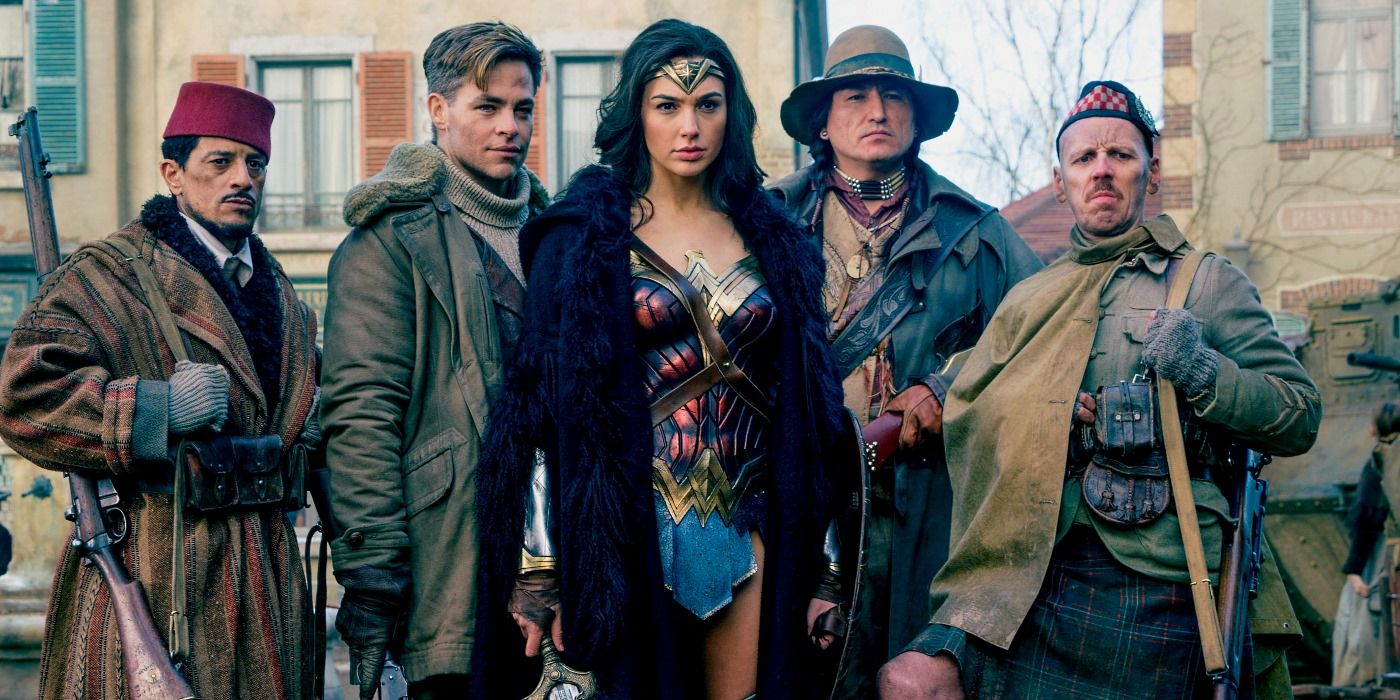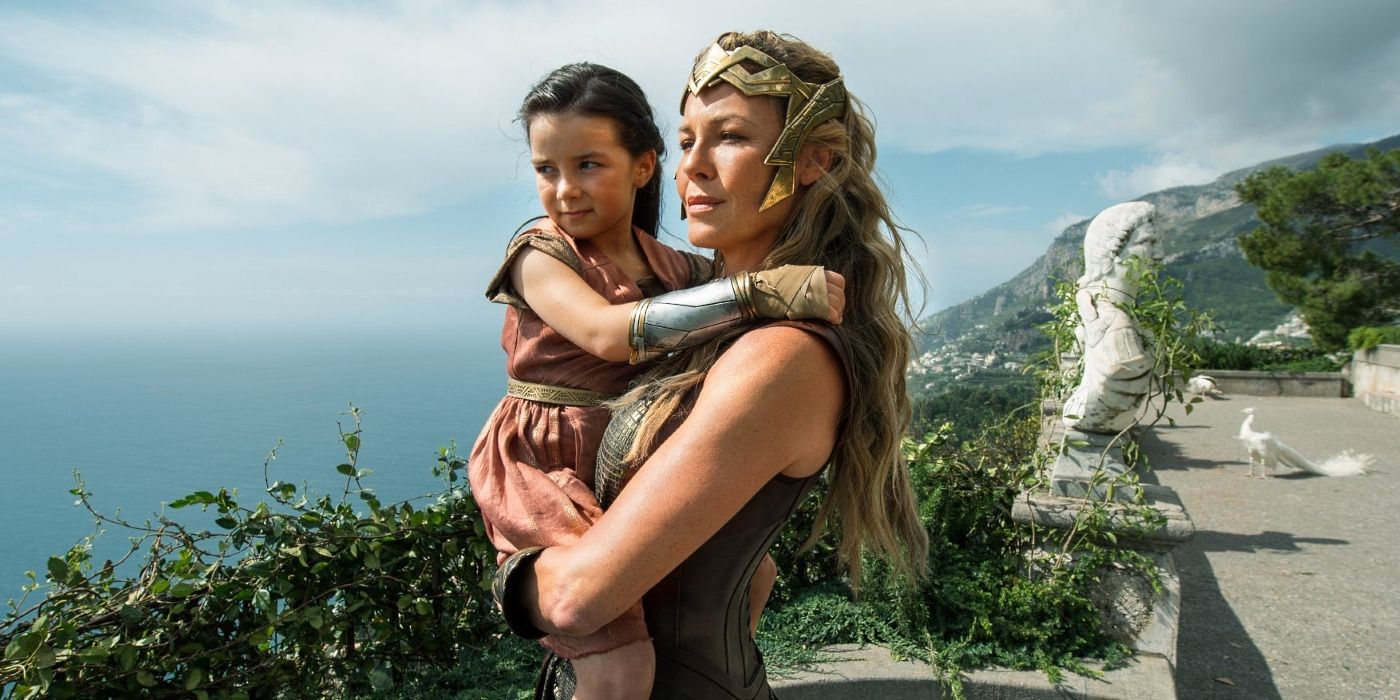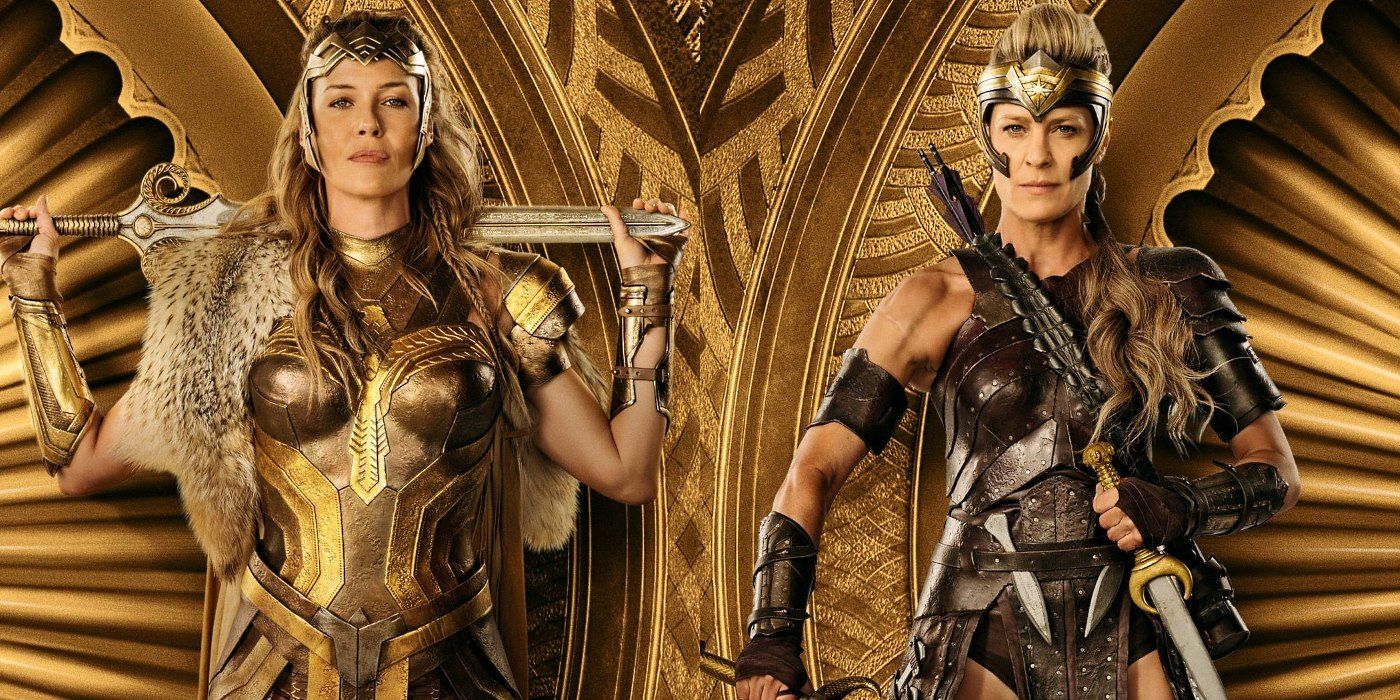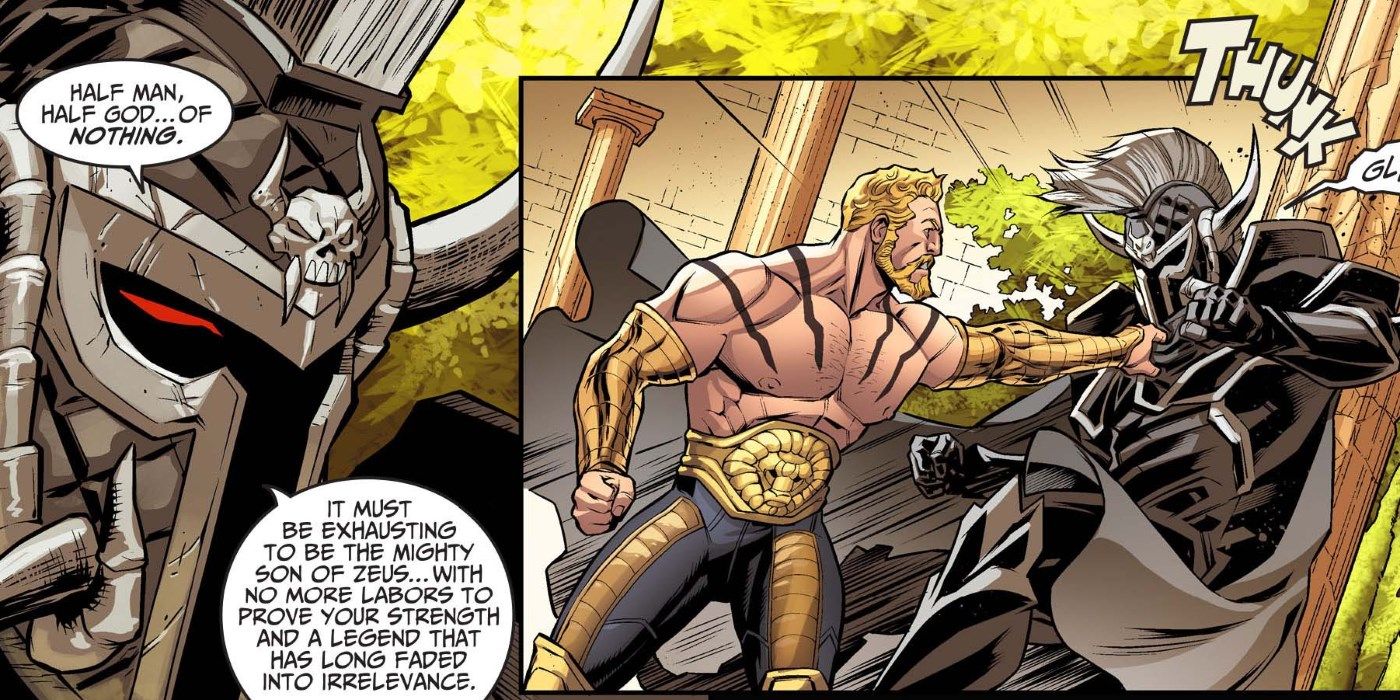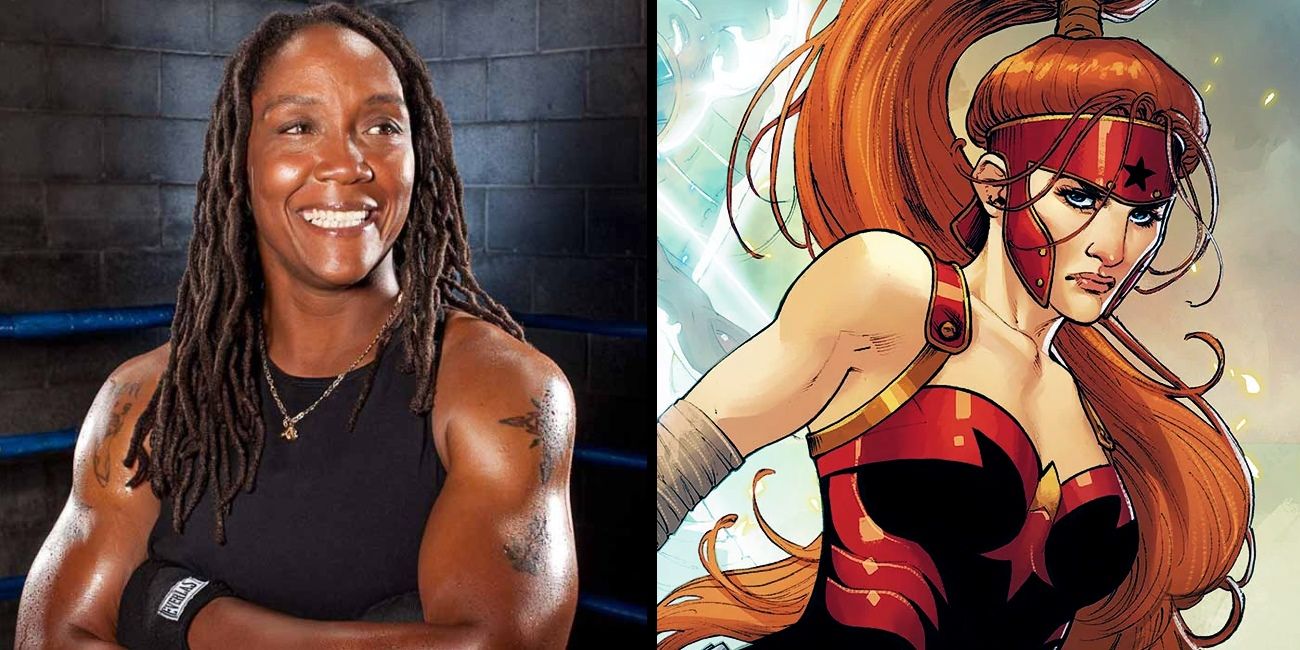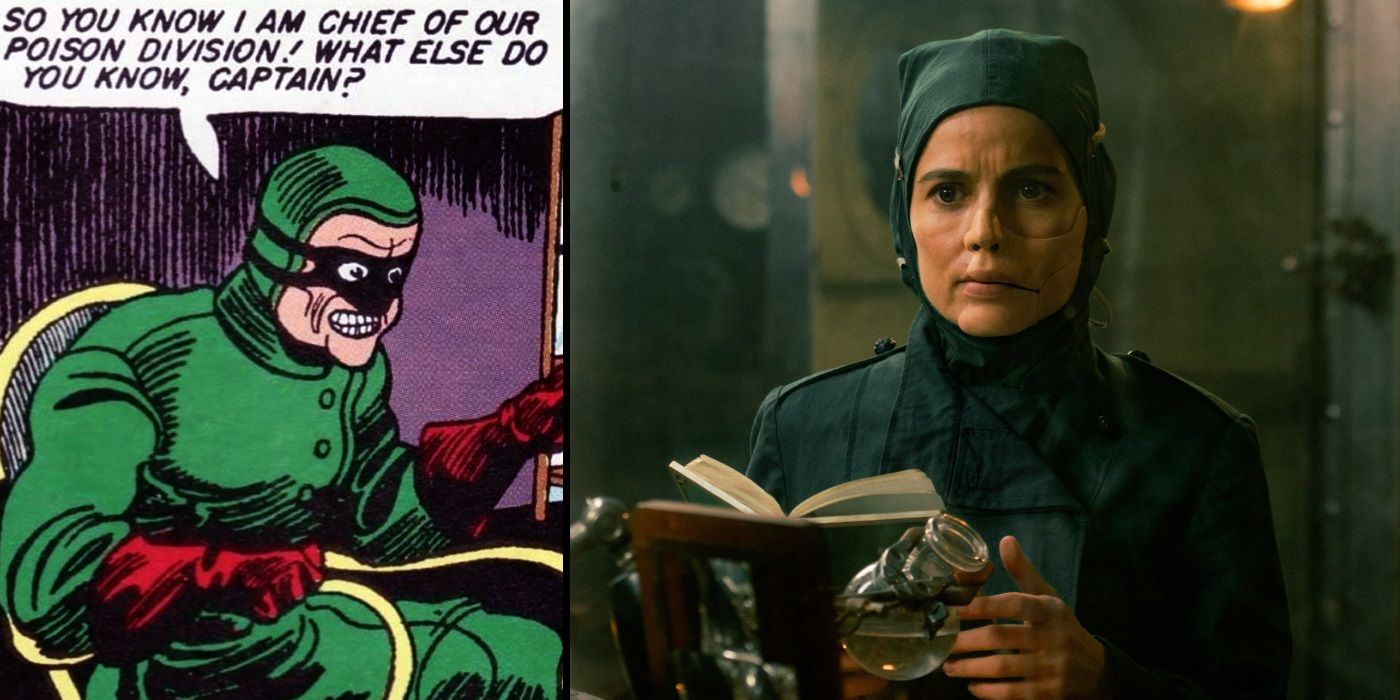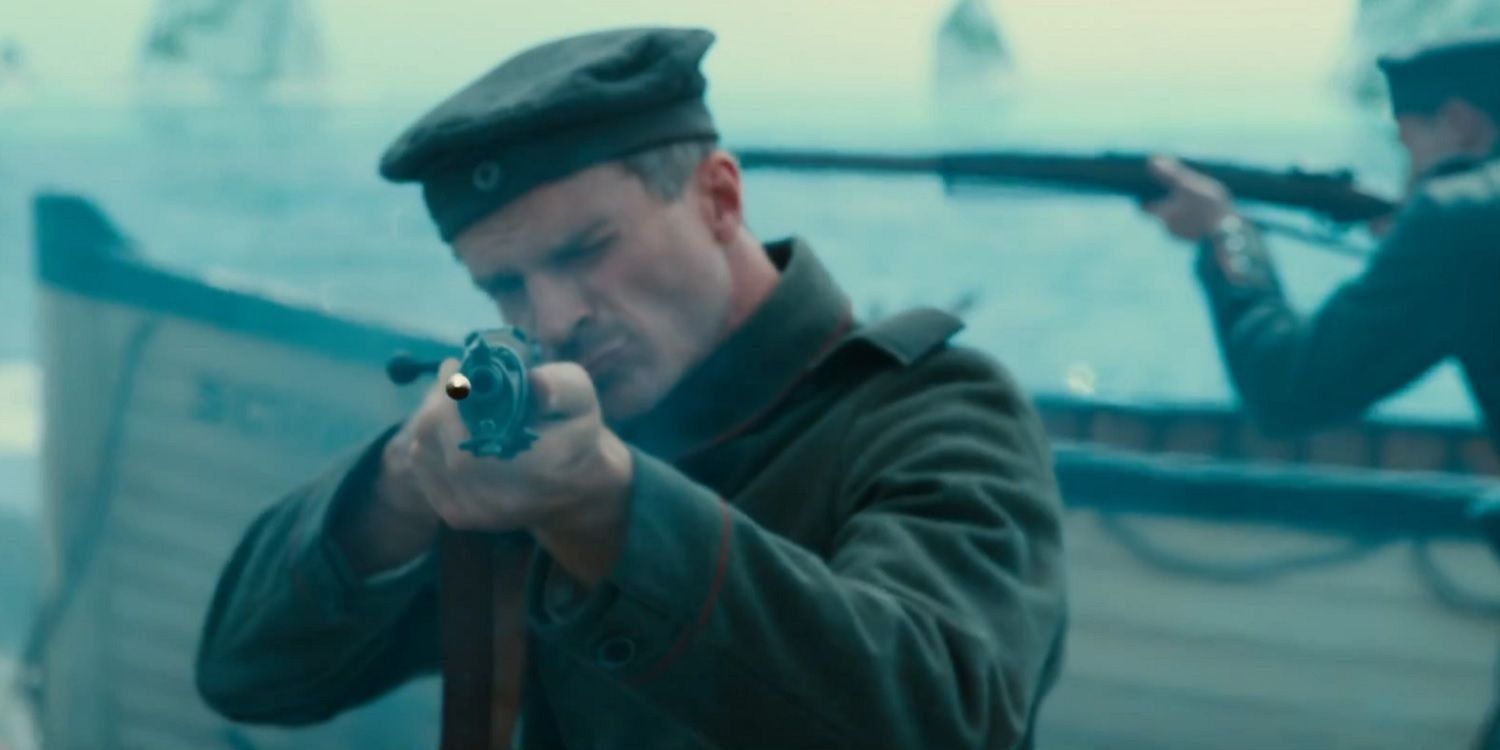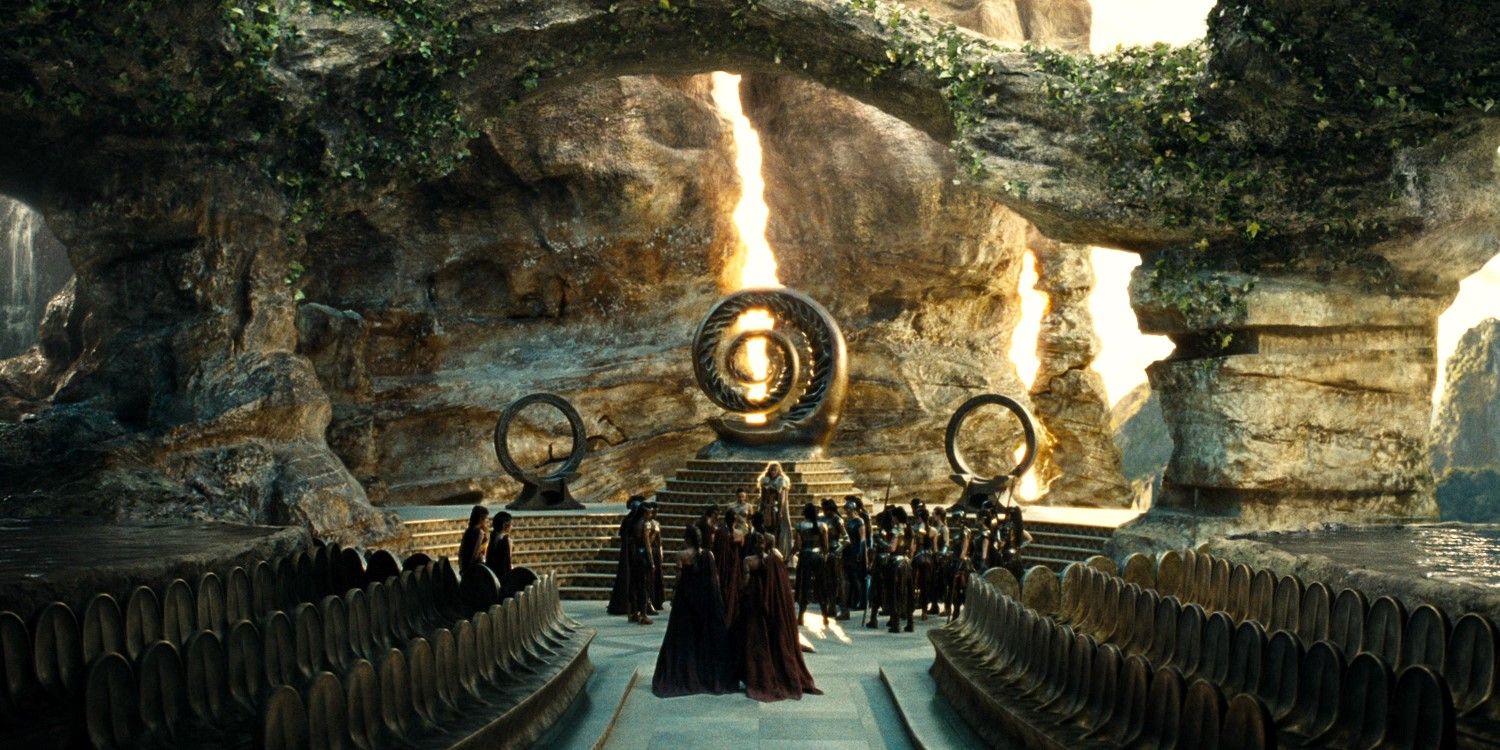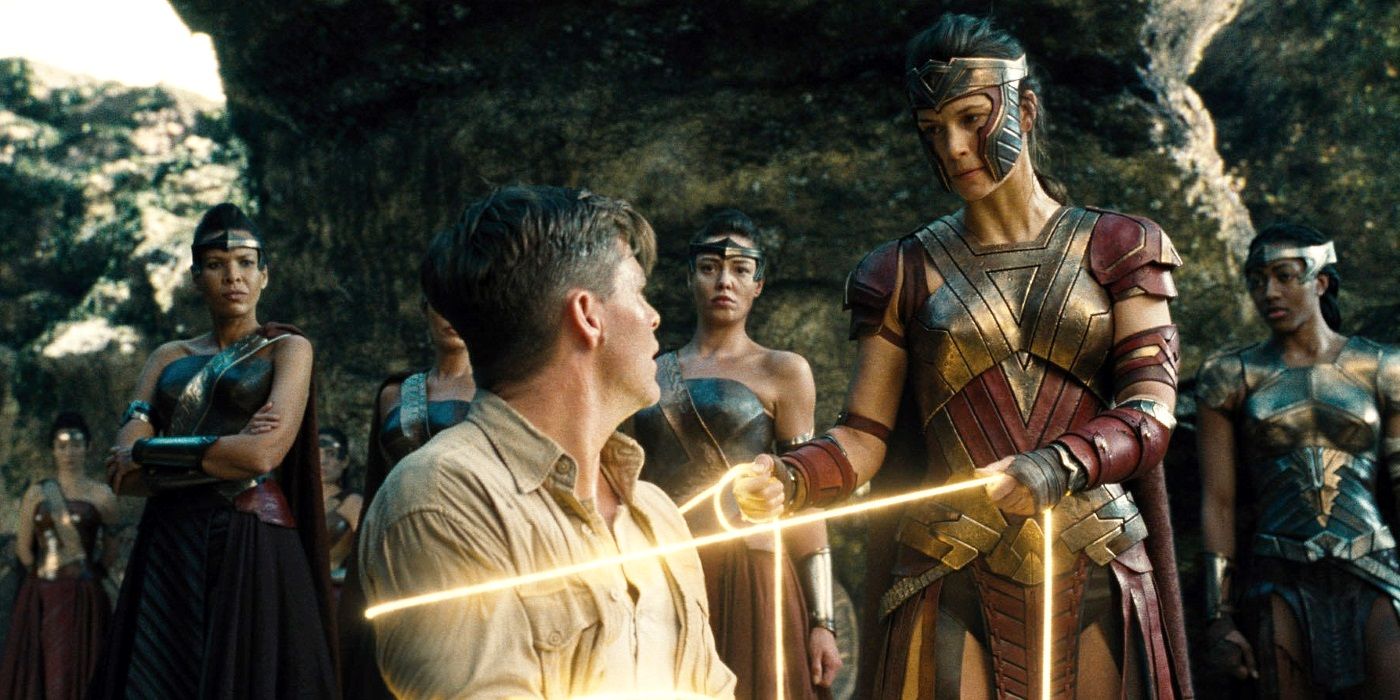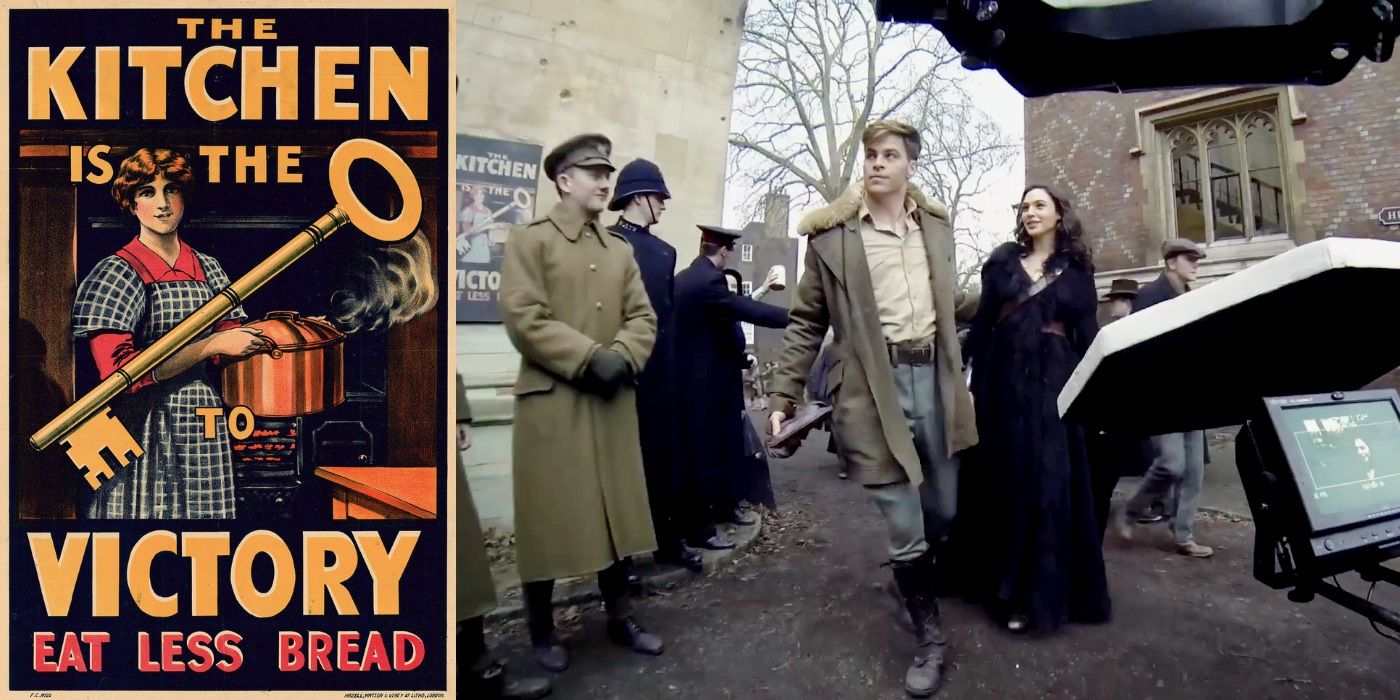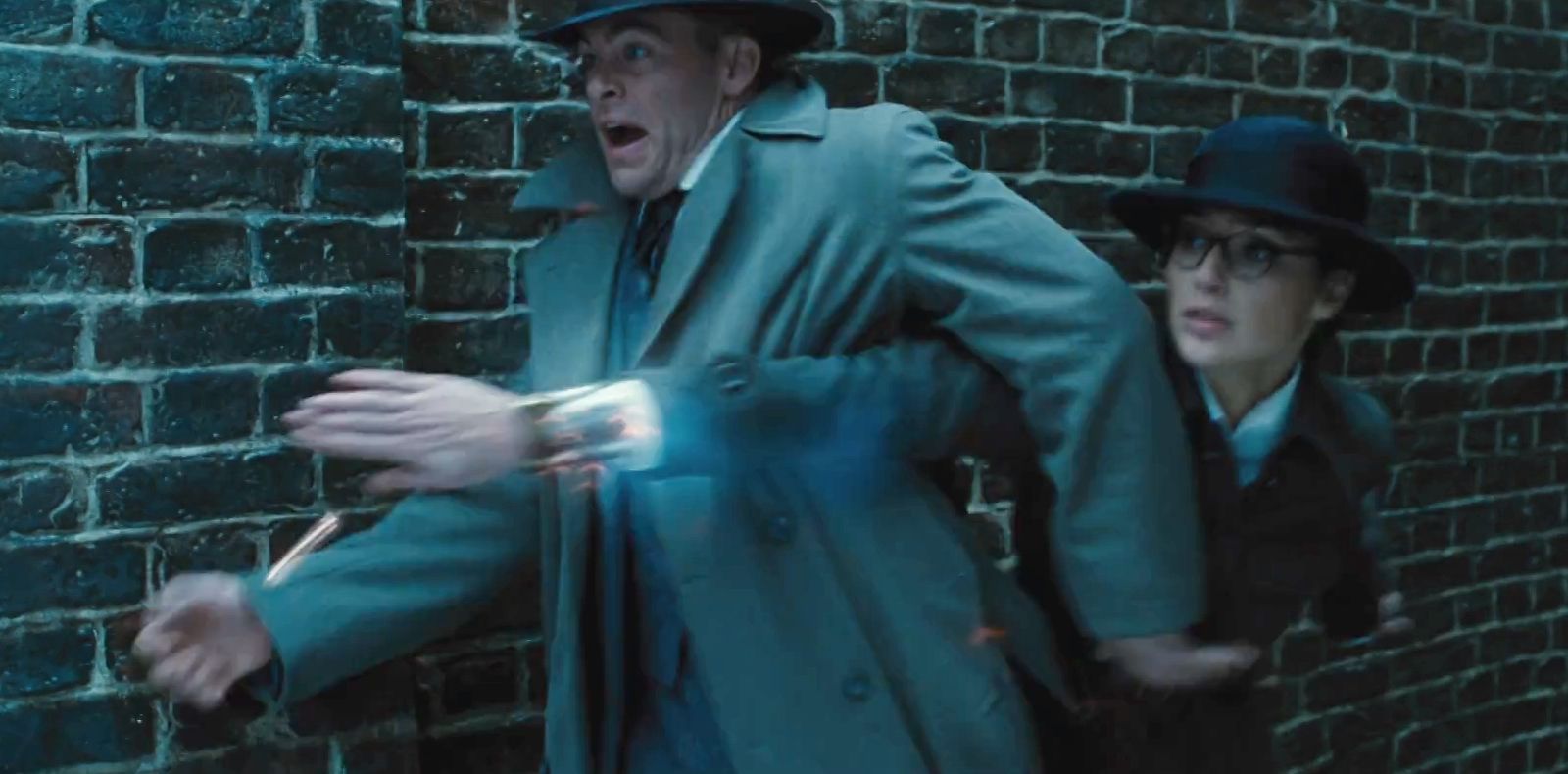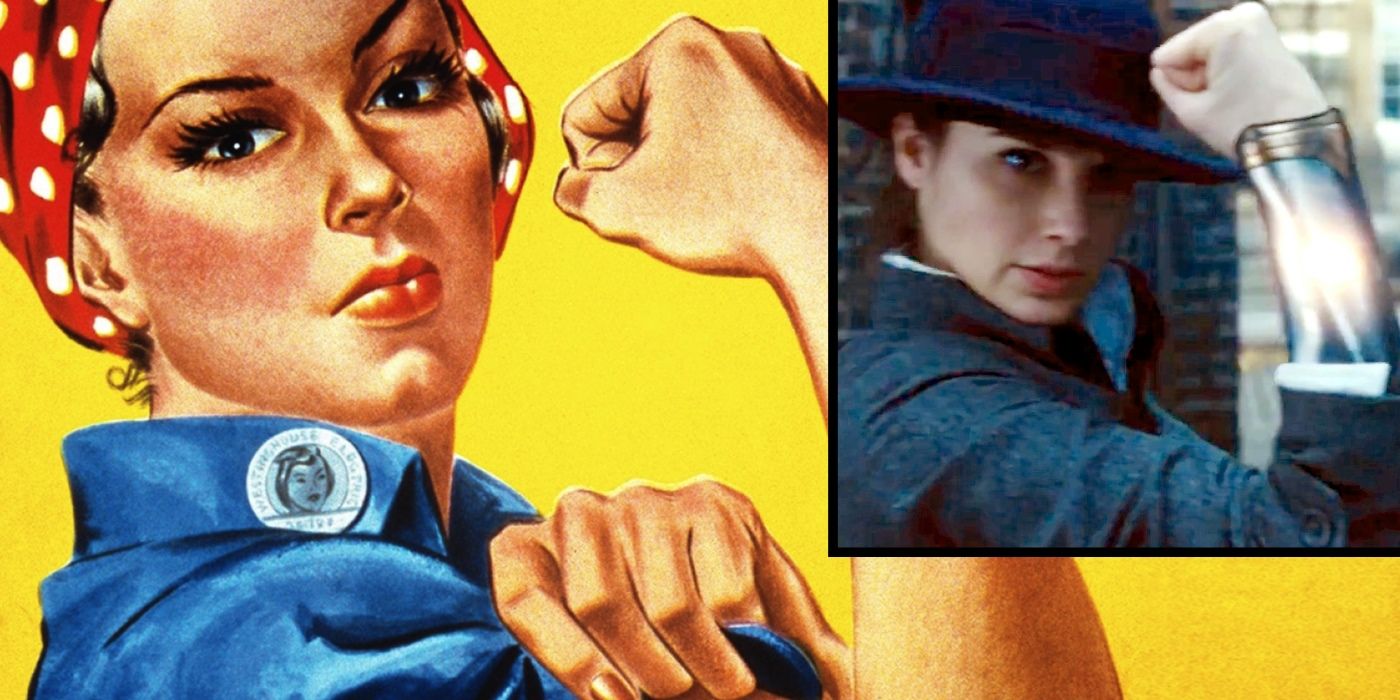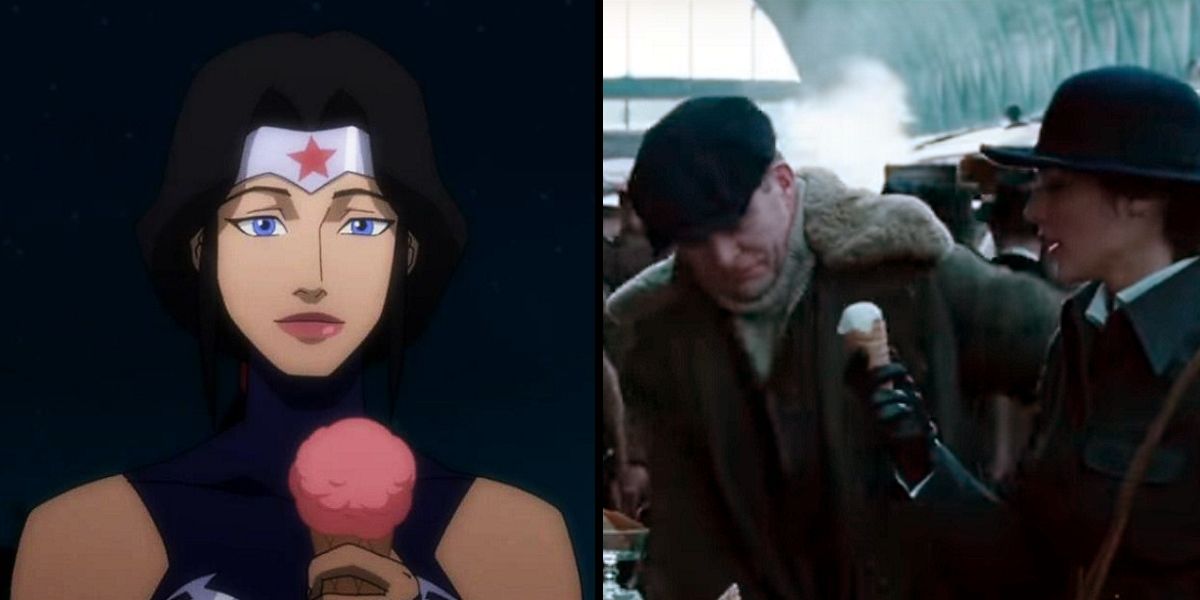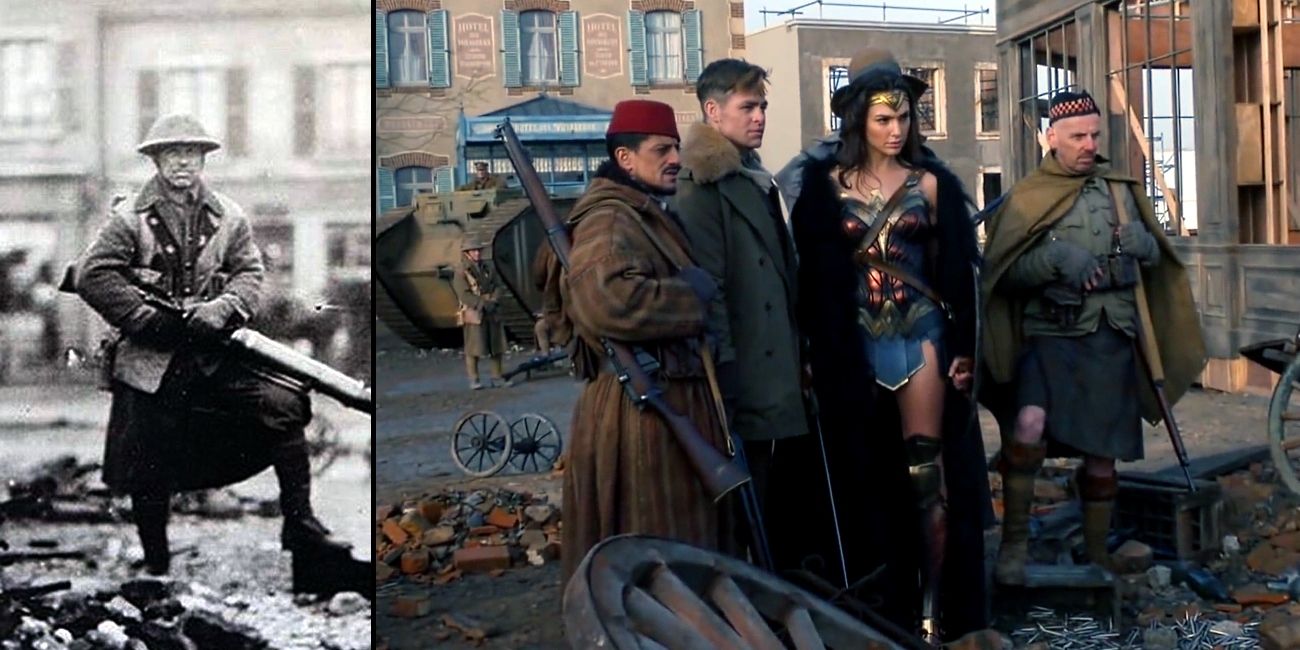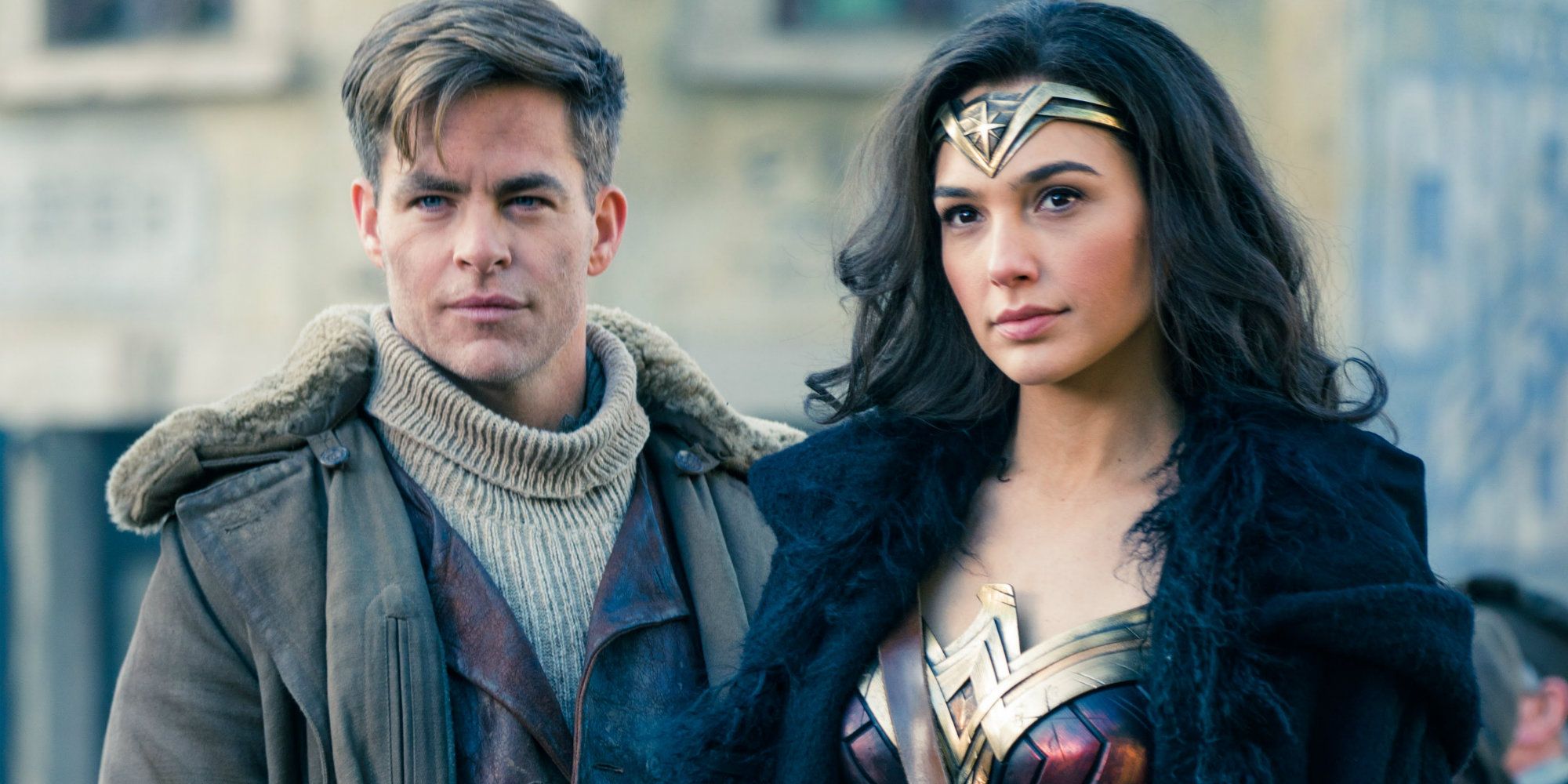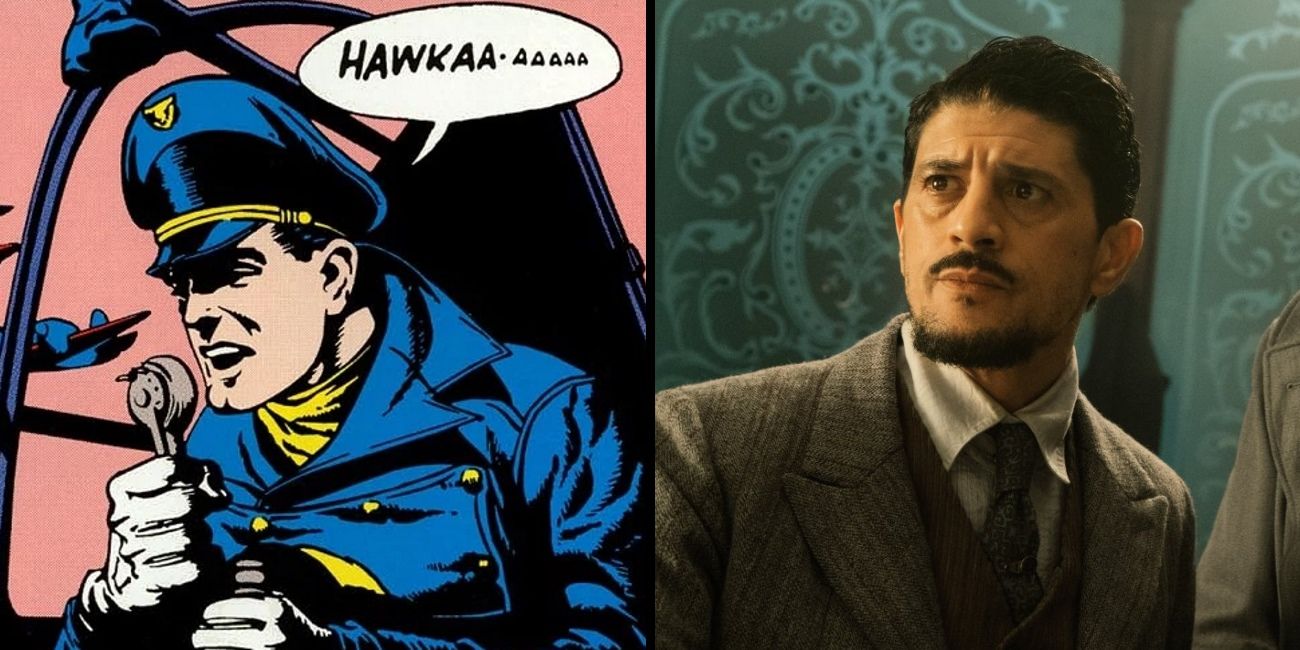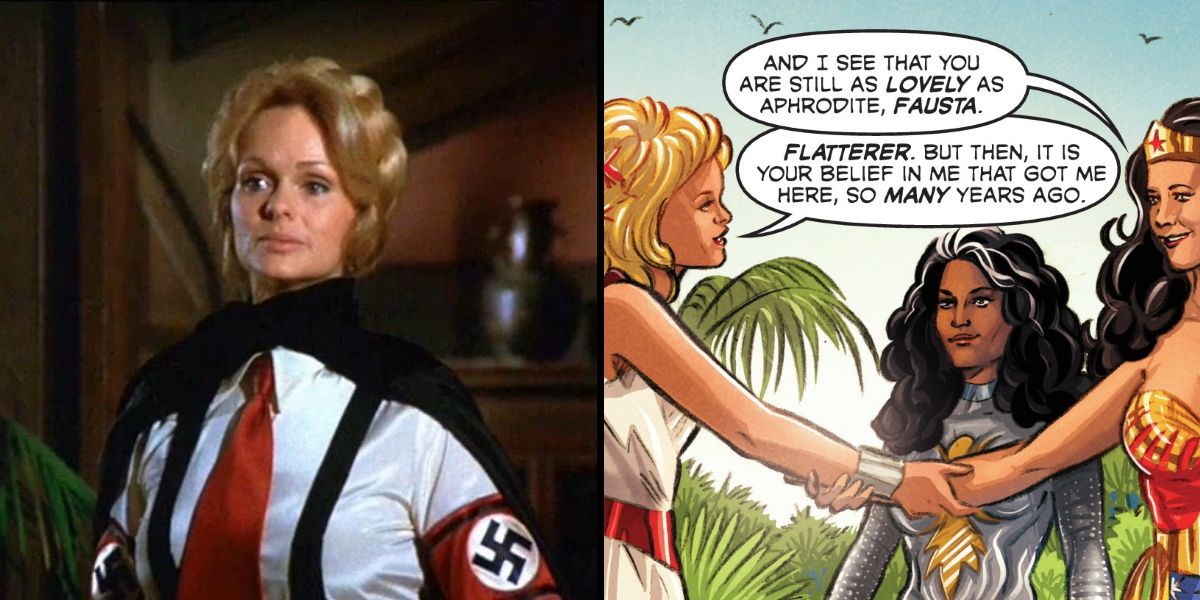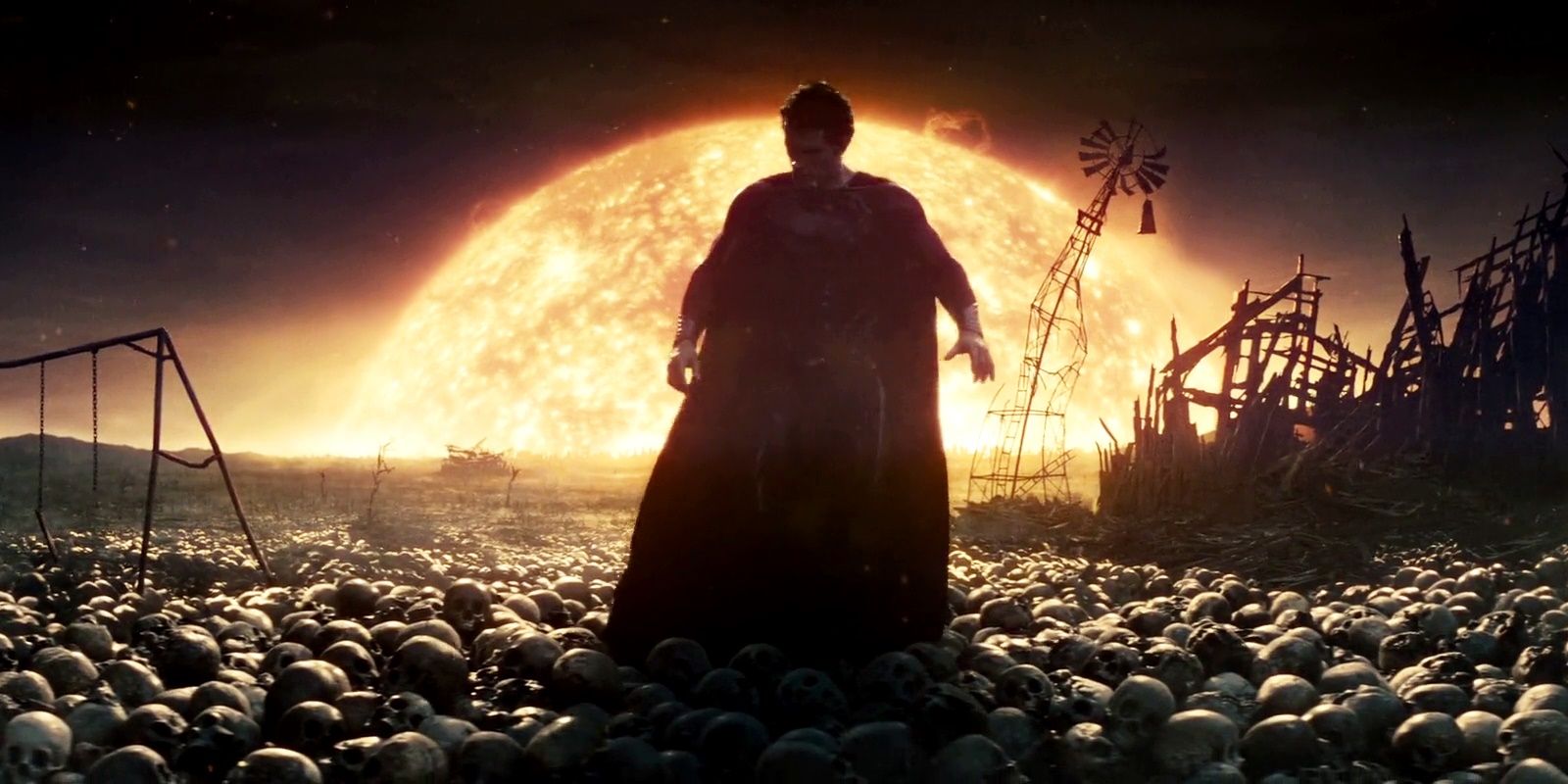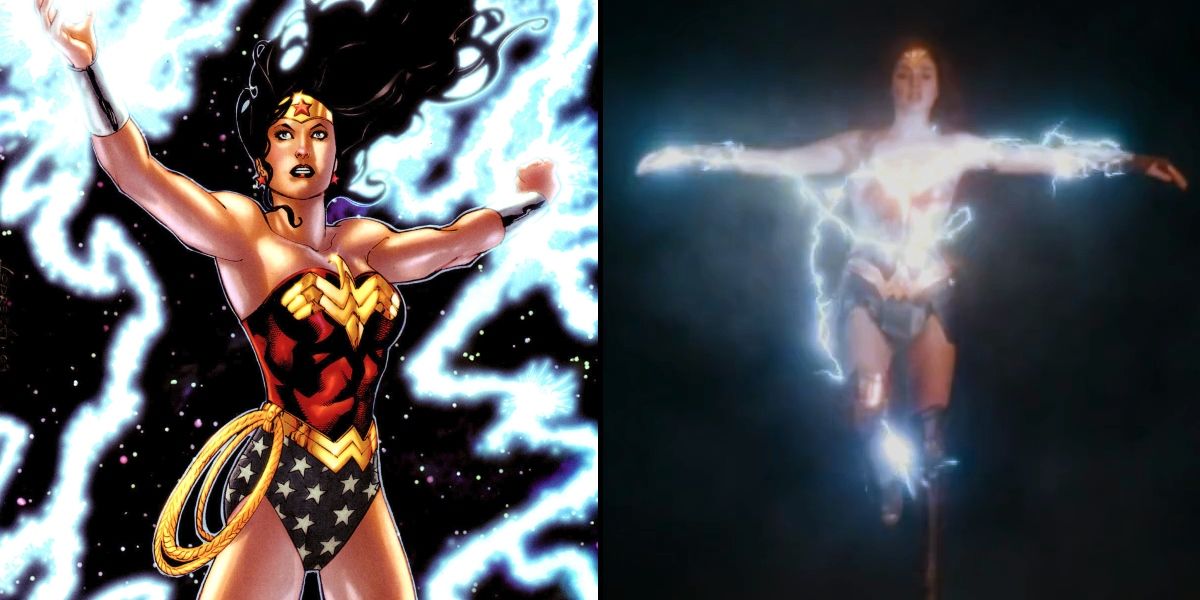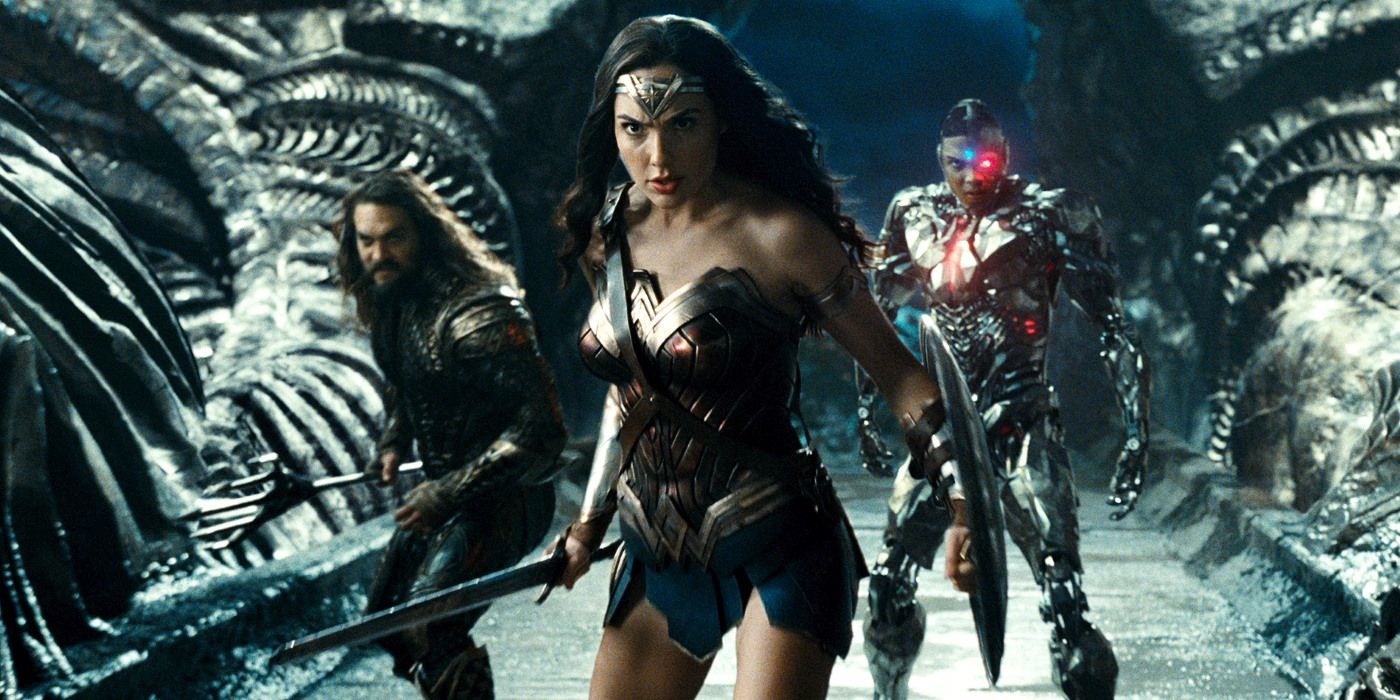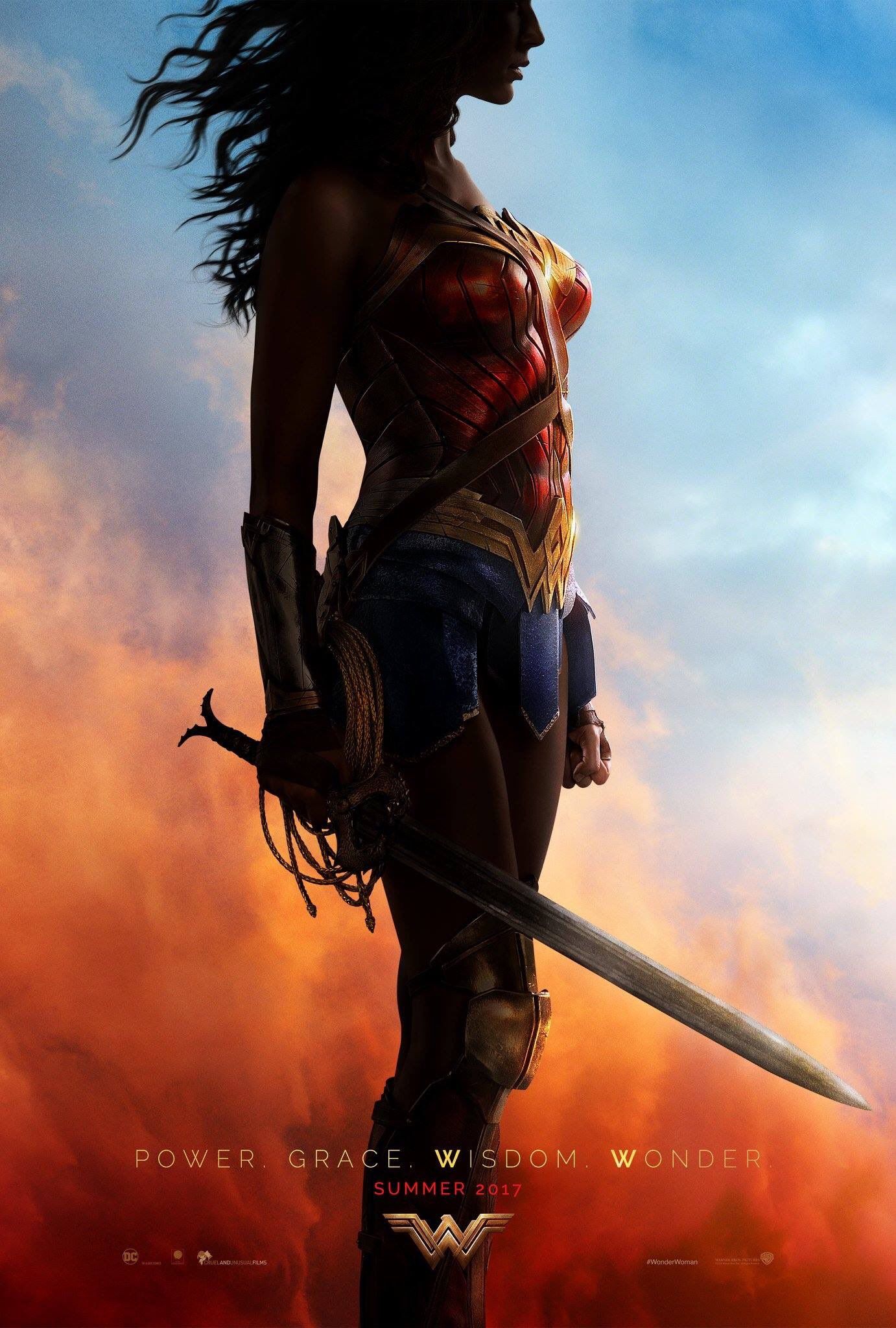WARNING: This article contains MASSIVE SPOILERS for Wonder Woman.
-
DC's biggest heroine has arrived, which means every Wonder Woman easter egg, cameo, secret connection to the DCEU, and niche nod to DC Comics is being placed under the microscope. Director Patty Jenkins made sure to pay tribute to the comic book mythology and origin story of Diana of Themyscira, and the results speaks for themselves. This may be Wonder Woman's very first feature film... but it's hard to find elements of her origin story or the history of the Amazons that aren't adapted into DC's movie universe.
These secrets vary from specific moments in DC Comics history being alluded to (only noticed by the die-hard fans) to the subtlest of story details and production design fans of modern superhero movie-making have come to expect. And even if Wonder Woman is a new style in the DCEU thanks to taking place primarily a century before the rest of the universe, that doesn't mean there are any fewer goodies to search for in, around, and behind the action.
Needless to say, there will be some major SPOILERS in our breakdown of Wonder Woman Easter Eggs & Comic References.
20. The White Peacocks
In the original comics, the question of how a society of women would be able to survive on a single, remote island was easily answered. While on Themyscira, no Amazon would need sustenance to retain her full strength and health, which is why you'll rarely see Amazons sewing crops, or feeding livestock. That doesn't mean there isn't any wildlife on the island, even if the movie doesn't highlight much more than horses. But keep your eyes peeled to the background of a handful of shots, and these regal birds are hard to overlook.
They appear to be leucistic or albino peacocks: male members of the peahen species with longer tails, best known for using their extravagant coloring to attract a female mate. Their presence suggests that on Themyscira, men are still relevant to reproduction, in the world of proud fowl, at least. But the idea that males ‘court’ women is completely done away with. These birds are beautiful, yes... but guileless.
19. Born From The Lake Bed
The story of the Amazons has changed a bit over the run of Wonder Woman comics, sticking closer to, or straying farther from the mythological accounts. The Amazons get a new DCEU origin in this film, and as comic book fans might expect, the story Queen Hippolyta tells her daughter has a few subtle nods to what came before. It begins with an account of mankind's creation, before Zeus realized that he would need some more reliable protectors of his creation than his son, the DCEU's Ares, God of War. And so, he created the Amazons to guide man back to the light.
Zeus didn't get the credit for creating the Amazons in the original comic story, with that decision coming from a group of women among the Olympian gods. Having preserved the souls of women who died by a man's hand, unjustly, these gods created a race of women to give said souls new life. They formed them from clay at the bottom of a lake, with Hippolyta the first born, and Antiope following soon after. The storybook version told by Hippolyta to Diana leaves out the specifics of the Amazons' formation - but shows them emerging from a lake all the same.
18. A Nod to Hercules
The narrative of how the Amazons came to exist on their hidden island is divided between Hippolyta and Antiope, with the latter presumably telling Diana the parts her mother wished her not to know (or deemed her too young to hear). The story seemed to swing in Zeus's favor as he gifted man his Amazons as, in Diana's later words, "a bridge to a greater understanding," but mankind soon returned to their dark ways, enslaving the Amazons so that Hippolyta eventually needed to lead their war for freedom - one which the gods apparently joined them in, earning the ire of Ares.
The story doesn't need to be any more specific, but the DC fans know just what Hippolyta is likely referencing. In the original Wonder Woman comics, it was Herakles (or Hercules) whom Ares sent to Themyscira to challenge Hippolyta in combat. When the famed champion lost, the Queen invited his men into their city to feast, having been impressed with Herakles's performance and character. At which point Herakles drugged the women, forced himself on Hippolyta, and stole her treasured, godly girdle. Enslavement of the Amazons came next, so it appears this version of the story could be the same one in the DCEU.
In which case, Herakles is currently paying for his crimes by secretly supporting the entire island from beneath it.
17. Ann Wolfe's Artemis
It's no wonder that the young Diana has such a clear passion for the art of war and weapons, as the first shots of Themyscira show the warrior women intensely training en masse. It's our introduction to Antiope, the greatest military commander on the island - second only to Queen Hippolyta - as she strolls through her forces, observing their training, and inquiring as to some of their progress. But one warrior stands apart: Artemis, famed for her role in the comics, and one of the film's most notable cameos.
Artemis is played by Ann Wolfe, widely considered to be the greatest female boxer ever, having held four different titles consecutively (and winning 24 of her career's 26 bouts). Director Patty Jenkins made the announcement prior to the film's release, and Wolfe can be easily spotted in two scenes. First during the sparring sessions (taking a shot across the back, and simply staring down the offending Amazon), and later as the penultimate opponent of full-grown Diana, before Antiope steps in to unlock her true potential.
16. Doctor Poison's Goggles
Members of the audience who either rush home to research 'Doctor Poison,' or those who familiarized themselves before the movie will know that the film version is an homage, at most. The original take on Maru/Doctor Poison was a far cry from the brilliant, but meek, and disfigured doctor played by Elena Anaya. She still wore a mask, but it was something more befitting a science fiction mad scientist... and also intended to disguise her gender, operating as a man until a dramatic reveal (dramatic for the Wonder Woman comics of the day).
That means that the older fans will be disappointed to see the adaptation keep so little of the original... but there is a small detail to pay tribute to her roots. The green lab coat and apron she wears is a little too generic to be considered an overt easter egg, but the same can't be said for the massive goggles perched atop her head. She's never seen actually wearing them in the movie, allowing them to stand as a wink to the comic fans conjuring images of the strange goggles that were once the classic Wonder Woman villain's signature design detail.
15. The SMS Schwaben
Steve's account of escaping Ludendorff and Maru's secret chemical weapons plant doesn't technically explain how he was tracked and shot down by a German battleship, or how the ship managed to follow so closely behind him - piercing the veil of Themyscira just minutes after he crashed through it. Just a few minutes more, and boat loads of German soldiers are headed to shore to apprehend him (and open fire on the Amazons that appear to defend their princess). In all the action, the history buffs in the audience might not realize that the identity of that ship is actually revealed.
The boats carrying the soldiers are stenciled with the name “SCHWABEN” – a reference to the very real historical dreadnought battleship SMS Schwaben. Launched in 1901, the ship operated before and during World War I, but since that action was primarily in the North and Baltic Seas, it's hard to know why it was chosen. The only reason we can think of is that someone in the production team had a sense of humor, and fondness for German naval history: in 1905 the Schwaben actually replaced the outdated and obsolete SMS Mars - the Roman name for Ares.
14. Hippolyta's Thrones
Although the architecture, armor, artwork, and fighting style of the Amazons may be based in the classical Roman and Greek societies in which their deities were worshipped, there's one difference. The presence of stone columns - a major feature in most Greek and Roman plazas - is significantly downplayed, most likely as a decision to reduce the presence of 'phallic' imagery on an island of all women. In its place is an architecture more clearly based on flowing lines and circles (not unlike Diana's Lasso of Truth).
Nowhere is this imagery more visible than in the throne room of Themyscira, where Steve Trevor is taken once the skirmish on the beach has been settled. The women warriors towering over him, and the magical means of his interrogation steal the show, but the throne is worth some extra attention. Where one might expect a throne of this kind of society to be large, tall, symmetrical, and built from rigid stone, the opposite is true. The chair upon which the ruler of the Amazons sits reflects her: imposing, beautiful, and endless. Now just to find out who originally forged it.
13. The Lasso of Truth
The first marketing for Wonder Woman confirmed that she would be using more than a sword and shield in combat, relying instead on her signature golden lasso. It functions on film much as it did in the comics, imbued with magical energy so that Diana could wield it as an extension of her body. But the movie sees it used for its original purpose: forcing those wrapped in it to tell only the truth, through magical enchantment that has been slightly inconsistent over the decades of comic history. In the film, though, it's given a proper name: the Lasso of Hestia.
While it's typically known as the Lasso of Truth (for obvious reasons), the movie's name keeps the comic origin intact. The lasso does draw its power from the goddess Hestia, even if the thread or twine used to make it has changed origins. Oddly enough, Hestia isn't associated with "truth," but domesticity, family, and households or community. That definitely applies to the Amazons, but thankfully the movie offers one explanation: Hestia is mainly the goddess of the hearth (the household fireplace), explaining why it gets unbearably hot until Steve confesses the truth.
12. Period-Accurate Posters
The audience may be viewing the streets of early 20th Century London as Diana does, meaning some of the smaller touches may get lost in the shuffled. Thankfully, set photos and footage from behind the scenes show the extent to which Wonder Woman's art department went to keep the backdrops period-accurate. Among them, as visible in the above image, is one such propaganda poster printed by Hazell, Watson & Viney Ltd. during World War I. With women primarily left behind on the homefront, such propaganda professed the value of aiding the war effort even outside of combat - in this case, by "eating less bread" so that more could be shipped overseas to the fighting men.
The themes of domesticity, sacrifice, and the idea that others should go without so that the men being killed overseas can have more all feed into the time and place (and the image of an endlessly-fueled meat grinder on the front). But this propaganda marks an important shift in the way wars were fought in the modern era. Prior to World War I, the idea of a "national army," or literally "a nation at arms" wasn't as widespread as it would become. Countries has armies, sure, but the idea of a nation stopping its progress and funneling all wealth, production, and population into a war is what World War I made commonplace. It also introduced the notion of the "homefront," implying that even the women and children at home were embroiled in the conflict... even if their efforts amounted to "eating less bread."
11. The Bullet Catch Homage
The idea that Diana of Themyscira would be turning the usual dynamics of 1916 society on its head was driven home early in the film's marketing, thanks to one scene in particular. As Steve and Diana enter an alleyway shortly after departing (with a new disguise) from Etta, they find themselves ambushed. But before Steve can try to talk his way out of the problem, one of Ludendorff's spies fires a bullet aimed straight for his heart. It finds Diana's bracer instead, knocking the heated bullet directly into Steve's hand. Once the sting wears off, he realizes what Diana is capable of, and lets her take the lead.
It was the kind of loving tribute to Richard Donner and Christopher Reeve's Superman that any fan spotted instantly. The scene being reference, for those who can't recall, comes from the original Superman film in which Clark and Lois find themselves similarly ambushed by a mugger. Where Clark - in the hat and glasses this time - plays the unassuming wimp before catching a bullet headed straight for Lois Lane. Patty Jenkins confirmed the nod when it was posed, as one of the more literal signs of the spirit of Donner's Superman living on.
10. Reminiscent of Rosie
Speaking of classic homages teased in that very alleyway shootout, the image of Diana raising her arm to deflect a bullet - and leaving it suspended there for effect, arm flexed - was instantly latched onto by fans. The connection, they claimed, is that yet another wartime woman was showing (quite literally) that "We Can Do It!" just as the famous WWII-era motivational poster of that very name promised. Even though the fighting, flexing women hail from two different wars, it's hard to ignore the similarities.
As a point of clarification, the poster commonly referred to as 'Rosie the Riveter' is actually not an image of that particular war-era figure. The painting was commissioned by Westinghouse to only be used as motivation for their employees, for a total of - shockingly - just two weeks. Decades later the art was found and spread like wildfire, apparently now even informing one of the most impressive scenes in Wonder Woman's own big screen blockbuster. So we suppose it's "We Did It!" now?
9. Diana Discovers Ice Cream (Again)
The first easter eggs for the film managed to leak ahead of its release, since scenes involving Diana discovering the wonders of mankind's miraculous "ice cream" aren't easy to miss. It originally appeared in the New 52 relaunch of DC's Justice League heroes, with Diana taking on a swarm of Harpies attacking the American public. Once the dust had settled, she shared a moment with a young girl who soon opened her world to the frozen treat. It was recreated almost perfectly in the animated movie Justice League: War, and now makes its jump to live-action as one of several nods from director Patty Jenkins and the writers to the comic book source material.
In the film, it's Steve Trevor who gets to enjoy Diana's discovery as she picks up a cone at a train station (as the two begin their journey to the front). This time around it's simply a scoop of vanilla, but it has the same impact. Diana declares it "wonderful" just as she did in both comic and animation, and even adds the words of praise to the vendor that he "should be very proud."
8. Zack Snyder Cameo
Not long after Wonder Woman debuted in Batman V Superman, fans shared their excitement online of seeing the DCEU already taking shape as an interconnected universe. The prime example (aside from the Justice League teases) was a the photograph acquired by Lex Luthor, sought by Diana, and eventually unlocked by Bruce Wayne. Showing Diana in her full armor and large coat, audiences actually got to see the co-stars still filming her own origin movie. And Patty Jenkins soon confirmed that the easter egg went both ways: that very photo was of a scene in which Zack Snyder would cameo.
A black and white photo proved Snyder would appear as a U.S. soldier following the liberation of the town in question (Veld), and while he may be difficult to spot in the movie, a bit of official B-Roll footage seems to show where to look for him. The soldier standing behind the group, and slightly to their left looks to be a dead ringer for Snyder, who can now add a Wonder Woman role to his performance as Bruce Wayne's hands in Batman V Superman.
7. 'Paradise Island'
Steve Trevor is a curious onlooker, at best, during his time spent on Themyscira. But even if he's not filled in on the details or magical sciences of the Amazons' home, he learns that it's a place unlike any in the rest of the world. Which is why he eventually brings up Diana's home after spending days heading for the Western Front, referring to it as "Paradise Island." Diana meets the impromptu nickname with a smirk, understanding along with the audience that the name "Themyscira" was as difficult to pronounce in the early 1900s as it is today.
It's a moment aimed squarely at the earliest days of comics, when Wonder Woman when creator William Moulton Marston imagined the Amazons occupying Paradise Island. It was meant to convey a fantastic, mythological sanctuary rendered almost perfect simply by man's absence ("paradise" could only exist where man had not yet explored). The name Themyscira wasn't actually introduced until 1987, and while the island itself may have changed since then, it's nice to see the film honor both traditions.
6. Sameer is a Blackhawk
Early on it didn't seem that the film's selection of colorful personalities surrounding Diana on her mission would be pulled from the comics. The characters of Charlie (Ewen Bremner), Chief (Eugene Brave Rock), and Sameer (Saïd Taghmaoui) drove home the idea that Diana and Steve would be fighting on behalf of multiple nationalities or ethnicities, as all mankind would be opposed to the corruption of Ares. But as one member of the cast eventually let slip, his character apparently is meant as a connection to the Blackhawks of DC Comics.
The Blackhawks, or Blackhawk Squadron may not be major players in the current DC Universe, but owe their creation to World War II. The team started when a Polish pilot took the moniker as a WWII pilot, soon adding more and more pilots and fighters, all drawn from countries with reason to take on the Axis Powers. While it's never stated explicitly in the film, Saïd Taghmaoui shared a photo of him in full costume as Sameer next to a member of the Blackhawks (Andre Blanc-Dumont, specifically). Whether it's canon or a callback to Said's own French roots, it's nice to see a sign of the Squadron at all.
5. Fausta Grables
Given the difference in tone, time, and war, there aren't too many direct references to the well-known Wonder Woman of TV, Lynda Carter. Although fans obviously hoped that Lynda Carter would cameo in Wonder Woman, everyone involved let them down easy long before it released. But as luck would have it, another classic DC Comics character does make a surprise, stealth appearance in the movie - assuming fans are willing to stick around for the credits...
You'll spot actress Rachel Pickup credited as Fausta Grables, playing the role of the famous Nazi operative (even if it's a war too early) only seen on her way to Ludendorff's gala. We never do find out how Diana manages to talk her out of that stunning blue dress, but if the comics are anything to go by, Elsa was always waiting for a chance to do the right thing.
4. "War is Truth"
It's hard to draw many meaningful, specific parallels between the Ares of the DC movie universe and the one from DC Comics, mainly because the former spends a majority of the film in disguise as Sir Patrick Morgan. But when he reveals his true nature, he comes prepared, with a lengthy monologue intended to win Diana over to his way of thinking. In short: that mankind isn't worth saving, and only he and Diana are left to realize it and start over. He reveals that he never forced the war to take place, but merely gave mankind the tools and inspiration - they were the ones who committed the horrors. In that sense, he argues, he is truly the "God of Truth," not War.
That line may sound familiar to comics readers, since it may sound like the kind of rationalizing (or actual clarity) you expect from a world-conquering deity. But that parallel was drawn by Ares himself back in Wonder Woman #37 (2009). As part of the "Warkiller" arc by Gail Simone and Bernard Chang, Ares surprised Diana by entering her home and claiming her famous lass for himself. His reasoning was that "War is Truth, Princess. By all rights, this should belong to me." Since it isn't the last nod we'll see to Simone's famous run on the character's title series, we'll chalk this one up to the same inspiration.
3. Flashback To Man of Steel?
When Ares begins that monologue (which will sadly fail, as every fan knows it will), he does so with more than just words. Using his godly powers to pop into and out of existence and throw Diana off her game is one thing, but when she entangles him in her Lasso of Truth, he takes things to the next level. Firing electricity out of his fingertips and into the magic of the lasso gives him some power over Diana'as perception. Suddenly, she's no longer relying on her physical strengths to protect her, but her skills of mental fortitude. Using his power and the lasso, Ares transports Diana to an imaginary version of the world, one able to be born into a brand new world after the one spoiled by mankind has been reduced to ash and fire.
Diana soon breaks free of the illusion, but is nevertheless shaken by this warping of reality. Meanwhile, DCEU fans in the audience are likely to realize that she and Superman now have a similar experience in common - since General Zod pulled almost the identical trick on the hero in Man of Steel. The similarities - the entrance into a dreamlike state, a false version of the world used to manipulate and seduce the hero, and the eventual escape from the illusion - all seems a callback to Superman. They play somewhat different purposes in the end, but it just goes to show how DC's villains attempt to turn the heroes to their side before being forced to destroy them (that's their plan, at least).
2. Diana's Lightning Attack
When the film's climactic battle really begins, and Diana begins to unleash her true power as a daughter of Zeus, it becomes clear just how much Wonder Woman's new powers will impact the future. It didn't take us completely by surprise, however, since out first glimpse of Diana hovering in the air, arms spread in the early trailers seemed like a massive hint for her final reveal. The effect was expanded upon in later trailers and TV spots, confirming that Diana wins the battle by using her father Zeus's lightning.
It's not the first time that she's had that ability, with writer Gail Simone making the update back in Wonder Woman #39 (2010), In that story arc the ability to project lightning by joining her metal cuffs was a gift from Zeus, since said cuffs were forged from his own aegis. It's an important difference, since the armor seems to have little to do with the lightning in the film, but they're not explicitly shown not to. Either way, it's one clear link to Simone's run on the character, which has since been hailed as among the very best of the modern era.
1. End With A Boom?
Fans already know, and hopefully understand why Wonder Woman has no post-credits scene, with producer Charles Roven simply explaining that there doesn't need to be one, and usually there isn't. The decision not to add a "tease" for Justice League was obviously a simple one, since the timeline of the film alone leaves little explicit connection between Wonder Woman and the DC team-up film... right? Well, there's reason for fans to hope, even if it means reading a whole lot into the film's final scene.
With the majority of the film told as a memory of Diana's (kicked up by Bruce Wayne's note and photograph), the action returns to the present for its conclusion. It's accompanied by a voiceover from Diana explaining that she has once again taken up her role as a guardian angel of the world, and protector against otherworldly threats. And right on cue, a low 'boom' in the distance catches her attention. She suits up, and leaps into the horizon to take on this new mission.
So in the modern era, after Diana has met Bruce and returned home... a loud "BOOM" begins her next mission - perhaps the opening of a Boom Tube of Apokolips? We don't know that the scientist kidnappings in Justice League are confined to Gotham or Metropolis, so perhaps Wonder Woman leads directly into Justice League. That's just speculation for its own sake, but an ending we'll believe in util it's refuted.
-
That does it, DC Comics fans: every Wonder Woman cameo, secret, or comic book reference buried in the dialogue, action, or background of Patty Jenkins's blockbuster. In the repeat viewings to come more are guaranteed to be spotted, so be sure to let us know in the comments.

